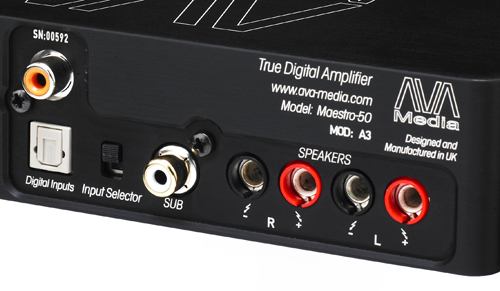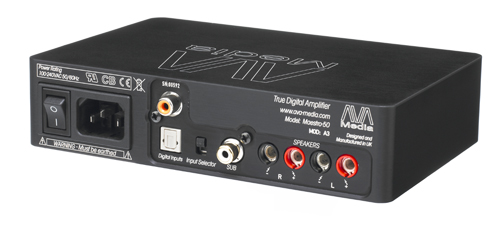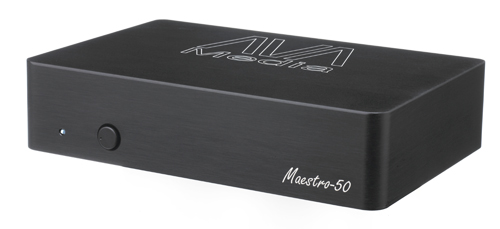What Hi-Fi? Verdict
Worth considering if you really need a very small stereo amplifier. It’s not a brilliant sonic all-rounder, though
Pros
- +
Beautifully made
- +
Compact size
- +
Clear yet fluid sound
Cons
- -
Just two inputs
- -
No USB
- -
Turns aggressive when pushed
- -
Does not convey the pace of music or dynamic changes very well
Why you can trust What Hi-Fi?
AVA Media is a small British company best known for its range of media servers and rippers. In a rather unusual move it has branched out into stereo amplification and the result, the AVA Media Maestro-50, is interesting enough to grab our attention.
AVA Media Maestro-50 Review: Connections
The Maestro-50 is a forward-looking unit that caters for digital sources only. There are just two inputs, both digital – optical and coaxial – and these are capable of accepting music files of up to 24-bit/96kHz resolution. There’s also a subwoofer output for those who want more bass than their stereo speakers alone can provide.
The amplifier keeps the signal in digital form as long as possible to maintain signal integrity. It’s a Class D design that takes a PCM (Pulse Code Modulation) signal and coverts it to a PWM (Pulse Width Modulated) stream, up-sampling eight times in the process. This PWM signal is fed into the power stage and filtered before being fed to the speakers
The AVA Media Maestro-50’s power output is quoted at 50 watts per channel, though the conditions this is measured under are generous to say the least. Judged by conventional industry standards and into an 8ohm load, it ends up at 20W per channel – which is still pretty decent for such a compact, relatively cool-running design.

AVA Media Maestro-50 Review: Build and specification
We have few concerns about build: this is an immaculately constructed little box. It’s about the size of a chunky paperback and at 1.2kg pretty hefty with it. Compared with the folded-metal chassis of most hi-fi amplifiers, the Maestro-50 has a hewn-from-solid feel to its aluminium casework.
The only letdown is that the stick-on plastic feet on our review sample didn’t need much encouragement to slide around and ultimately fall off. It’s easy enough to stick them back on, but it’s a disappointing feature.
We do have a few issues when it comes to the specifications and ergonomics. An amplifier such as this lends itself to be used with a computer, so a USB input would be nice.
We put the question to the manufacturer, and it turns out that including a USB input would have pushed the price up too much. AVA Media makes a USB to SPDIF (Co-ax and optical) converter for those who need a USB connection. That will set you back £60.
It’s a shame the input selector is mounted on the rear panel – it’s awkward to get to, particularly when the amplifier is fully wired up.
There’s no remote control either, which may not be an issue if the amplifier is used close-by on a desktop, but could limit its appeal if used in a more traditional set-up. The volume level is adjusted by a small pop-out control. Once out of use and pushed in, it helps give the amplifier a neat, uncluttered look.

AVA Media Maestro-50 Review: Sound
In use the AVA Media Maestro-50 gave us mixed results. It’s a small unit, so when the resultant sound has good scale it’s impressive.
Listen to XX’s Coexist and the Maestro-50 delivers a pleasingly clean and defined sound. The well-recorded vocals are crisply reproduced with a decent sense of expression. There is a nicely unforced way of reproducing sound that makes long-term listening a real possibility.
At low to medium levels it’s a smooth listen with very little hardness in the sound. Push just a little more, though, and things change things notably with the presentation becoming coarse and edgy.
With just 20 watts per channel to play with this amplifier won’t deliver floor-shaking volumes. Once again, if used in a computer-based set-up this is not an issue, but it matters if the amp is to be used in wider applications.
The Maestro-50’s detail levels are pretty good for the money, and its presentation is organised in a stable and composed way right up until a piece of music gets complex. Then, things start to get a little confused.
Rhythmical precision isn’t a strong point either, so the momentum of songs such as Kanye West’s Power is diluted somewhat, as is its sense of dynamic punch.

AVA Media Maestro-50 Review: Verdict
The Maestro-50 is a safe-sounding product. It may not be a particularly exciting listen, but it’s pleasant enough provided you don’t get too demanding.
Move away from sound and (feet apart) it’s beautifully constructed. There are things to like here, but the Maestro-50 has restricted appeal.
What Hi-Fi?, founded in 1976, is the world's leading independent guide to buying and owning hi-fi and home entertainment products. Our comprehensive tests help you buy the very best for your money, with our advice sections giving you step-by-step information on how to get even more from your music and movies. Everything is tested by our dedicated team of in-house reviewers in our custom-built test rooms in London, Reading and Bath. Our coveted five-star rating and Awards are recognised all over the world as the ultimate seal of approval, so you can buy with absolute confidence.

